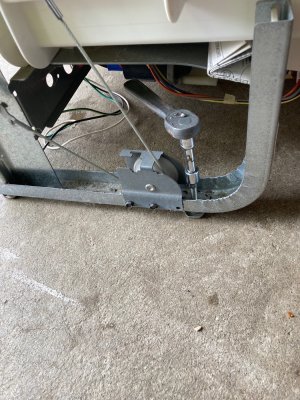I feel your pain! My gremlins are actually quite mean to me… if I drop a fiddly bit which I follow with my eyes all the way to the floor, by the time I reach down to retrieve it, IT’S GONE! I will now spend an inordinate amount of time searching the floor. I may even vacuum with a panty hose filter on the end to no avail. Once I sit up and return to the work bench, the little BA$TARD has placed right on the bench in plain sight!There must be. Whenever I drop a small part (like an eyebolt or deadeye) it simply disappears. The gremlin grabs it and takes it who knows where. He usually returns the part anywhere from a few hours to a few days later, sometimes longer. Then he places it in a spot I KNOW I had thoroughly searched before. I can almost hear him laughing at my puzzled expression and cuss words.
-

Win a Free Custom Engraved Brass Coin!!!
As a way to introduce our brass coins to the community, we will raffle off a free coin during the month of August. Follow link ABOVE for instructions for entering.
You are using an out of date browser. It may not display this or other websites correctly.
You should upgrade or use an alternative browser.
You should upgrade or use an alternative browser.
Actually that would be the case. are you trying to mimic a Captain's room?
thats a big socket to just vanish like that.With me, the Gremlin lives in the apartment next door. Is already an ancient Gremlin who mainly observes everything in front of the window.
if i catch that guy, ill bbq the bastard!
- Joined
- Aug 6, 2024
- Messages
- 42
- Points
- 48

Is that a pet or just one of the features that came with the house?
Growing up in Hawaii, it was impossible to keep geckos out of the house. Maybe because it was impossible to keep cockroaches out…
Growing up in Hawaii, it was impossible to keep geckos out of the house. Maybe because it was impossible to keep cockroaches out…
- Joined
- Oct 9, 2020
- Messages
- 2,191
- Points
- 488

who needs cannons when you have a godzilla. lolYou guys may have Gremlins in your workshop but I have to put up with Godzilla
View attachment 500632
- Joined
- Aug 6, 2024
- Messages
- 42
- Points
- 48

Thanks for noticing my post. The creature in the picture is Sinbad. He is an anole, member of the iguana family. His number one job in the shipyard is dispatch
any fly, ant, roach, cricket or what ever he can find. It has been a wonderful relationship for us both. He has just come out of the captain's cabin on the Colonial Frigate Hancock.
any fly, ant, roach, cricket or what ever he can find. It has been a wonderful relationship for us both. He has just come out of the captain's cabin on the Colonial Frigate Hancock.
If he does spiders also, I'll hire him.
Another place you could look for your socket is under your dishwasher. We got a new one a couple of years ago and I found a socket, an extension, and a ratchet handle that had been under the old dishwasher for about 15 years. I guess I was distracted while leveling it.In the meantime, if anyone manages to catch their gremlin can you please get my 13mm socket back.

Another place you could look for your socket is under your dishwasher. We got a new one a couple of years ago and I found a socket, an extension, and a ratchet handle that had been under the old dishwasher for about 15 years. I guess I was distracted while leveling it.Fair winds!
View attachment 500982
Brilliant!
- Joined
- Apr 2, 2021
- Messages
- 582
- Points
- 198

Ha! I have a Gremlin from the same family as yours. However, mine takes the parts and pieces dropped and somehow manage to hide them in such a manner that they mysteriously appear in odd places all over the house. Apparently my wife is the only person that can discover these gems and she is the one that brings them to my attention for description. Generally long after I needed the part or piece which was usually the last one.There must be. Whenever I drop a small part (like an eyebolt or deadeye) it simply disappears. The gremlin grabs it and takes it who knows where. He usually returns the part anywhere from a few hours to a few days later, sometimes longer. Then he places it in a spot I KNOW I had thoroughly searched before. I can almost hear him laughing at my puzzled expression and cuss words.
Same problem, my theory is that I have a small black hole that attracts any small abject that if falling and squirrels it away in a different dimension for weeks at a time before bringing them back and hiding them in my wife's hoover.Ha! I have a Gremlin from the same family as yours. However, mine takes the parts and pieces dropped and somehow manage to hide them in such a manner that they mysteriously appear in odd places all over the house. Apparently my wife is the only person that can discover these gems and she is the one that brings them to my attention for description. Generally long after I needed the part or piece which was usually the last one.
- Joined
- Jun 17, 2021
- Messages
- 3,173
- Points
- 588

You Too? They must all be related. The MO of my basement shop dwellers is precisely the same. As much as year or more later I'll find the bloody part exactly as you describe, and, yes, you CAN hear the little buggers snickering somewhere just out of sight. If you have REEEALLLY good peripheral vision, I swear you can almost see them!There must be. Whenever I drop a small part (like an eyebolt or deadeye) it simply disappears. The gremlin grabs it and takes it who knows where. He usually returns the part anywhere from a few hours to a few days later, sometimes longer. Then he places it in a spot I KNOW I had thoroughly searched before. I can almost hear him laughing at my puzzled expression and cuss words.
I find that an excellent way to find something that I know full good and well that I have- or that I've seen just a few days before that I now need- is to buy another one. Sure as the sun comes up every day, you can be assured I find it the next day!
I think I could build a complete model from the parts I have lost on the floor over the years. That is if I could ever find them all.There must be. Whenever I drop a small part (like an eyebolt or deadeye) it simply disappears. The gremlin grabs it and takes it who knows where. He usually returns the part anywhere from a few hours to a few days later, sometimes longer. Then he places it in a spot I KNOW I had thoroughly searched before. I can almost hear him laughing at my puzzled expression and cuss words.
You forgot Chaos Theory!There is no need to consider mythical beings. Science can explain this phenomenon.
If we could find where gremlins hide the stolen parts, we might be able to retrieve them along with missing socks and food container lids. Fair winds!
- Entropy: The second law of thermodynamics introduces us to entropy, which tends to increase. The higher the entropy the higher the disorder. In other words, nature does not like little parts to be where you think they belong but prefers them scattered about.
- Murphy's Third Law: Anything that can go wrong will go wrong.
- Murphy's Fourth Law: If several things could go wrong, the one that causes the most damage will be the one that goes wrong. In practice, this means that if you drop and lose a small part, it's likely to be the part of which you don't have any spares.
- Heisenberg's uncertainty principle: You cannot know both the position and the velocity of a particle at the same time. This works against accurate estimation of the direction and distance that a small part travels when dropped.
- Search Theory: It's always in the last place you look. Since you can't know where the last place is, you may need to look in an infinite number of places to find what you lost.
- Gravity: According to Einstein's theory of general relativity, gravity is the bending of spacetime. While Newton would have us believe that apples all fall toward the center of the earth, Einstein tells us that small parts can go almost anywhere.







